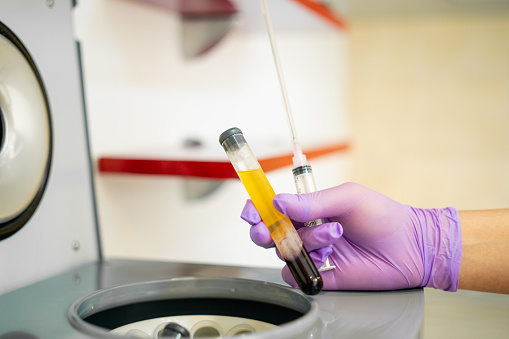
Is Platelet Rich Plasma Therapy Right For You?
by Alex Bocchi, DPT
AzOPT Goodyear Doctor of Physical Therapy
Platelet rich plasma therapy. You may have heard of the hype. But what is it? Who needs it? Does it work?
Platelet rich plasma (PRP) therapy is a form of regenerative medicine using your own blood to help repair and facilitate healing. The process first starts by withdrawing blood from the body and running the blood through a centrifuge to separate the blood. Approximately 2 ounces of blood is withdrawn and separated into plasma and platelets.
Plasma is a component of your blood that carries proteins and electrolytes. Platelets are used in blood clot formation. Recently, it has been suggested platelets can release growth factors in the body. With the combination of growth factors and proteins to help build structures, your own blood can be used to help stimulate the reparative process.
The process may take between 45 and 90 minutes, depending on the individual and injection site. Depending on the location of injection, an ultrasound machine may be required for precision. PRP is then injected into the target site and the needle is removed. Patients may return to work the next day depending on occupation. Most activities can be resumed in a couple of days, depending on doctor orders. Patients may receive their PRP injection at either a hospital, ambulatory surgical center, or private office. While AzOPT does not perform PRP injections, we do have several providers who we can recommend.
PRP may be used for various musculoskeletal conditions including cartilage issues, labrum tears, ligament tears, tendon tears, meniscal tears, etc. Patients who experience any of these injuries may benefit from PRP. One study examined NFL players with hamstring strains who received PRP. They were able to return to sport quicker than those without PRP. Other PRP studies have been shown to be beneficial for patellar tendon pathologies, lateral elbow tendinopathies, rotator cuff pathologies, TMJ, and bicipital tendinopathy. All reducing their pain and improving their function in the short and long term. PRP can be used for a variety of other conditions, as well.
What about steroid injections? PRP was actually found to be more effective in reducing pain and returning to function in the long term when compared to steroid injections. With PRP injections, you do not receive the negative long-term effects of steroid injections like weakening of tendons and ligaments and decreased bone density.
When it comes to physical therapy and PRP injections, research has shown that PRP combined with physical therapy is superior than just PRP alone. One study examined acute grade 3 MCL sprains and another study looked at TMJ dysfunction. It was found that PRP combined with physical therapy had reduced healing time and decreasing pain for both studies.
PRP can be used either for an acute injury or for a chronic injury. If you find yourself plateauing in physical therapy from a chronic issue, you may benefit from PRP injections to restimulate the healing process. Returning to physical therapy after your injection will allow you to maximize your potential to returning to pain free and prior level of function. Discuss with your therapist and doctor if you think PRP may be beneficial.
References:
- Alves R, Grimalt R. A Review of Platelet-Rich Plasma: History, Biology, Mechanism of Action, and Classification. Skin appendage disorders. 2018;4:18-24.
- Bagwell MS, Wilk KE, Colberg RE, Dugas JR. THE USE OF SERIAL PLATELET RICH PLASMA INJECTIONS WITH EARLY REHABILITATION TO EXPEDITE GRADE III MEDIAL COLLATERAL LIGAMENT INJURY IN A PROFESSIONAL ATHLETE: A CASEREPORT. International journal of sports physical therapy. 2018;13:520-525.
- Bradley JP, Lawyer TJ, Ruef S, Towers JD, Arner JW. Platelet-Rich Plasma Shortens Return to Play in National Football League Players With Acute Hamstring Injuries. Orthopaedic journal of sports medicine. 2020;8:2325967120911731-2325967120911731.
- Cheatham SW, Kolber MJ, Salamh PA, Hanney WJ. Rehabilitation of a partially torn distal triceps tendon after platelet rich plasma injection: a case report. International journal of sports physical therapy. 2013;8:290-299.
- Chen X, Jones IA, Park C, Vangsness CT. The Efficacy of Platelet-Rich Plasma on Tendon and Ligament Healing: A Systematic Review and Meta-analysis With Bias Assessment. TheAmerican journal of sports medicine. 2018;46:2020-2032.
- Filardo G, Di Matteo B, Kon E, Merli G, Marcacci M. Platelet-rich plasma in tendon-related disorders: results and indications.Knee surgery, sports traumatology, arthroscopy : official journal of the ESSKA. 2016;2018;26:1984-1999.
- Fitzpatrick J, Bulsara MK, O’Donnell J, McCrory PR, Zheng MH. The Effectiveness of Platelet-Rich Plasma Injections in Gluteal Tendinopathy: A Randomized, Double-Blind Controlled Trial Comparing a Single Platelet-Rich Plasma Injection With a Single Corticosteroid Injection. The American journal of sports medicine. 2018;46:933-939.







